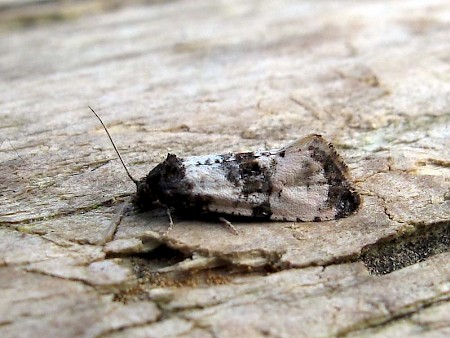49.139 BF966
Cochylis atricapitana
(Stephens, 1852)
Wingspan 12-16 mm.
Generally distributed throughout the British Isles, this species has a tendency to be commoner around the coast and on chalky ground. It differs from similar species by its dark head and thorax.
The adults fly in two generations, in May and June, and again around August.
The larvae feed on common ragwort (Senecio jacobaea). Early brood larvae in July start on the flowers and complete growth in the main stem, causing a swelling with an obvious hole where pupation occurs in a yellowish brown cocoon. The later larval brood feeds in September and October in the stems and rootstock, and overwinters there until pupation in April.
Larva: (description Ian F. Smith)
Foodplant: Flowers and in main stem of Senecio jacobaea in July. In main stem and rootstock, September - April.
Length: 6 mm and 9 mm described.
Head: Light brown, marked darker brown in posterior half. Frons edged dark brown. Black postero-lateral mark. Mouthparts dark reddish brown. Stemmatal area black.
Prothoracic shield: Translucent light brown, divided by yellowish medial line. Broad border of dark brown on posterior. Curved line of dark dots near medial line.
Thoracic legs: Translucent light greyish brown.
Body: Shagreened. Dull yellow. Translucent, showing gonads clearly and orange gut faintly.
Spiracles: Dark brown peritreme.
Pinacula: Light brown with very fine dark brown setal spot, and often one or two more similar spots without a seta. Pinacula on A9 darker and merged dorsally.
Setae: Small, colourless transparent.
Anal plate: Translucent brown, similar colour to pinacula on A9. With darker brown spots.
Prolegs: Coloured as body. Crochets reddish brown.
Anal proleg: Large lateral sclerite, lightly tinted as pinacula.

 UKMoths
UKMoths 








